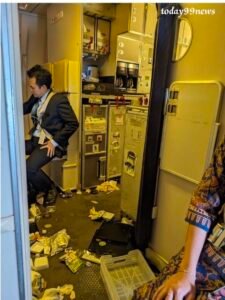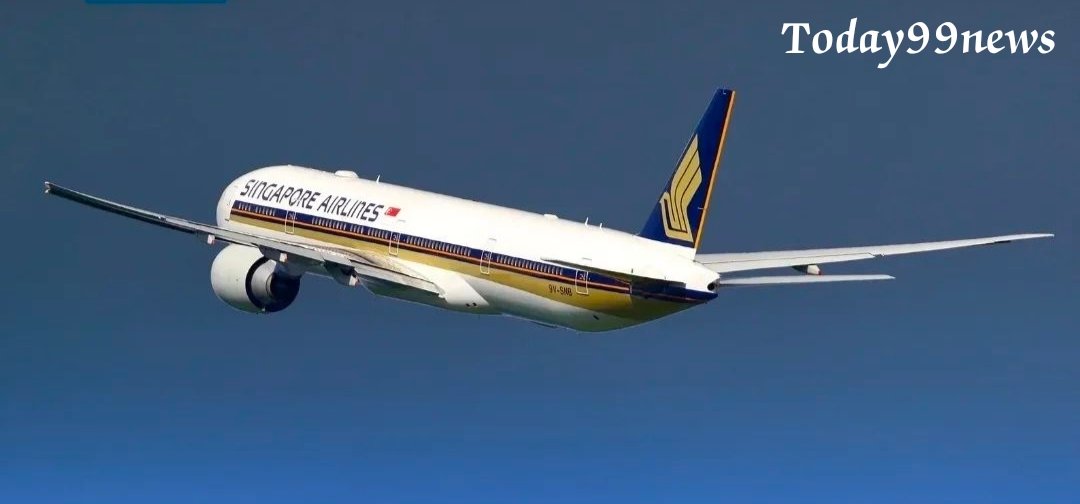One passenger aboard a Singapore Airlines flight died and at least 71 others were injured as a result of a severe turbulence occurrence.
On Tuesday, a Singapore Airlines flight from London to Singapore experienced extreme turbulence that resulted in 71 injuries and one passenger death. The airplane was forced to make an emergency landing in Bangkok as a result of the turbulence, which threw passengers and staff members throughout the cabin.

The airline reports that during the meal service, almost ten hours into the trip, above Myanmar’s Irrawaddy Basin, the Boeing 777-300ER experienced turbulence.
Business traveler Andrew Davis, who was on aircraft SQ321, told CNN’s Erin Burnett that everything was “perfectly normal” until the seatbelt indicator illuminated, and then “all hell broke loose” a few seconds later.
“It seemed as though the aircraft fell. I vividly recall seeing shoes, iPads, iPhones, blankets, cushions, silverware, dishes, and cups flying through the air and hitting the ceiling, even though it was probably only for a few seconds. The man sitting beside me had a coffee cup that flew straight up and struck the ceiling Davis remarked.

When Davis noticed other passengers with head injuries—one with “blood streaming down his face”—and an elderly passenger in “severe shock,” he claimed to have recognized the severity of the turbulence.
He reported A lot of screaming was heard.
The depth of the damage is visible in photos and videos taken inside the airplane, where emergency oxygen masks are suspended from the ceiling and overhead bins are left open. A picture of a galley displays a section of the ceiling exposed, revealing the interior of the airplane hanging below. On the floor are trays, containers, pots for hot beverages, and plastic bottles.
The autopsy procedure is still ongoing, according to Kitipong Kitikachorn, general manager of Suvarnabhumi International Airport in Bangkok, who announced on Tuesday that a 73-year-old British man passed away from what appears to have been a cardiac issue.
The individual was later identified as Geoff Kitchen, who had worked for the Thornbury Musical Theatre Group (TMTG) for more than 35 years and was referred to as a gentleman of utmost integrity and honesty by the organization.

According to CNN, the British Foreign Office is offering support to the family of the British traveller who lost his life on the Singapore Airlines flight.
Seated in the front of the aircraft, Davis claimed to have assisted in taking care of Kitchen, who sat behind him.
While many others required aid, we were able to assist this individual. I assisted in raising him removing him from his seat, and placing him on the ground to allow medical personnel to perform CPR Davis remarked. For around twenty minutes the passenger got CPR.
Six of the injured passengers had severe injuries, according to Samitivej Srinakarin Hospital in Bangkok, which treated the injured passengers. At least 71 individuals were hurt overall. Among the injured were nationals of the US, Ireland, New Zealand, Malaysia, the UK, and Spain.
According to Kitikachorn, who examined the aircraft, some of the injured passengers had fractured arms.
Around 10:30 PM local time, the aircraft—which included 211 passengers and 18 crew members—departed from London’s Heathrow Airport. Online flight monitors indicated that it was originally scheduled to land at Changi Airport in Singapore, but it was diverted to Bangkok instead, landing at 3:45 PM local time.
Videos taken following SQ321’s diversion to Bangkok depict emergency personnel removing a passenger from the aircraft on a stretcher.
About 200 people, according to Kitikachorn, were waiting for further planes to their destinations after landing in Bangkok. He mentioned that 131 of the 211 passengers were on a Singapore Airlines flight that later took off from Bangkok for Singapore.
The CEO of Singapore Airlines, Goh Choon Phong, stated in a statement that the carrier is offering the travelers and their families “every possible assistance and support”.
“I offer my sincere sympathies to the passenger’s family and loved ones on behalf of Singapore Airlines. We also sincerely regret the pain that every passenger and member of the crew on this flight endured.”
The US National Transportation Safety Board is sending staff to help in the probe, according to a statement from Singapore’s Ministry of Transport, which is also looking into the circumstances surrounding aircraft SQ321.
The flight possibly encountered rapidly developing storms.
Turbulence occurs when an aircraft flies through air masses moving at different speeds.
In mild and moderate turbulence, passengers might feel tension on their seat belts, and unsecured objects may move around the cabin. However in severe cases turbulence can throw passengers around the cabin causing serious injuries and sometimes fatalities.
Here is the complete translation of the Hindi content into English with a human-friendly tone:
The airline claimed in a statement that about ten hours after takeoff, the aircraft experienced abrupt, severe turbulence at an altitude of 37,000 feet above the Irrawaddy Basin, a river in Myanmar.
According to data from the aviation tracking website FlightRadar24, the aircraft makes a sharp descent, quickly climbs a few hundred feet, dips again, and then climbs once more before eventually reaching its cruise altitude. The total disruption, based on the data, lasted approximately ninety seconds.
After around fourteen minutes, the flight’s path is altered. The pilot reported a medical emergency and the aircraft was sent to Bangkok, according to the airline.
The airplane on Tuesday hit a swiftly forming storm in southern Myanmar, and strong turbulence was observed during the encounter, according to CNN’s weather analysis.
These kinds of tropical storms are common at this time of year when South Asia’s southwest monsoon season begins and the region’s humidity rises. When the land warms up in the afternoon, they can form quickly, especially in areas close to the coast.
Turbulence can still be produced by quickly growing speeds within developing storms, such as Tuesday’s, even if they may not show up on radar in their early phases. Storm cells can expand from 20,000–30,000 feet to over 50,000 feet in less than an hour.





 967437
967437




















